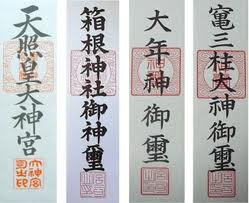:::::::::::::::::::::::::::::::::::::::::::::::::::::::::::::::::::::::::::::::::::::::::::::::::::::::::::::::::::::::::::::::::::::::::::::::::::::::::::::::::::::::::::
| Shinsatsu 神札 , Mamorifuda 守り札  . . . CLICK here for shinsatsu Photos ! quote Shinsatsu, Mamorifuda Shinsatsu are a type of thaumaturgic talisman (also known as gofu 護符 ) distributed at shrines and considered symbols of a spiritual being or its supranormal power. Shinsatsu may be made of wood, paper, or metal, and bear a written or printed inscription; the term is generally used to refer to the relatively large kind of amulets enshrined in kamidana, or affixed over gates, on doors and pillars, or on ceilings. Most are meant as general invocations against illness and accident, for safety within the home, national peace, and success in business, but others have more specific aims, such as protection from fire, theft, snow, or insects. Some bear complicated designs, such as those from the Kumano Shrines known as Kumano-goō. Certain kinds used from the end of the Heian period until the early modern period had a blank obverse side on which devotees could inscribe a dedication. Throughout the early modern period, the priestly functionaries (oshi) from the Grand Shrines of Ise distributed amulets called Jingū (Ise) taima たいま(大麻) and these also represent one kind of shinsatsu. special fuda talismans, shinpu 神符 Mamorifuda likewise represent a type of gofu amulet, but the term usually refers to a talisman distributed in a small bag made of brocade or ornate cloth and meant to be carried on the person. Like shinsatsu, mamorifuda may be made of wood or metal. Their origins lie in the talismans made by priests of Onmyōdō (Chinese Yin-Yang divination) or at Buddhist temples, and which later came to be produced at shrines as well. Mamorifuda can be found in a wide variety of types, the major kinds representing charms against illness and misfortune, invocations of household safety, safe childbirth, relief from snow or insects, traffic safety, safety at sea, and protection from bad fortune. Many are made to be worn on the body as personal invocations of divine aid. source : Okada Yoshiyuki - Kokugakuin University. . kamidana 神棚 household Shinto altar, "shelf for the Gods" . . Fudo Myo-O Gofu 不動明王の護符 talisman . . kekkai fuda 結界札(5枚1組) "talisman for the sacred boundary". ::::::::::::::::::::::::::::::::::::::::::::::::::::::::::::::::::::::::::::::::::::::::::::::::::::::::::::::::::::::::::::::::::::::::::::::::::::::::::::::::::::::::::: observance kigo for the New Year Yugyooji no fudakiri 遊行寺の札切 (ゆぎょうじのふだきり) cutting amulets at temple Yugyo-Ji ..... ofudakiri お符切(おふだきり) ..... hatsu ofuda 初札(はつおふだ) first amulet January 11 Amulets with the name of Amida Buddha 南無阿弥陀仏 are printed on paper, cut into small pieces and distributed to the pilgrims. The actual printing and cutting is not open to the public. . Temple Yugyoo-Ji 遊行寺 Yugyo-Ji . ................................................................................. observance kigo for late spring . o-fuda nagashi, ofudanagashi お札流 floating of temple amulets . Shikoku Henro Pilgrims 四国お遍路さん From Temple Nr. 44 大宝寺 to 53 円明寺 in the Matsuyama region, the amulets of pilgrims are floated in the sea at Takahama beach 高浜沖. On the 28th day of the third lunar month, now in April. ::::::::::::::::::::::::::::::::::::::::::::::::::::::::::::::::::::::::::::::::::::::::::::::::::::::::::::::::::::::::::::::::::::::::::::::::::::::::::::::::::::::::::: 守り札かけて育つやはつ茄子 mamori fuda kakete sodatsu ya hatsu nasubi growing strong protected by a talisman - first eggplants Kobayashi Issa 小林一茶  This eggplant talisman from the temple Zoojooji 増上寺 Zojo-Ji in Edo grants three wishes a grain of rice for plenty of food all year a knotted hair pin for finding a good partner a gold coin for good luck with money I am not sure this was already sold at the time of Issa. . eggplant, nasu 茄子 (なす), nasubi なすび . |
. Japan - Shrines and Temples .
:::::::::::::::::::::::::::::::::::::::::::::::::::::::::::::::::::::::::::::::::::::::::::::::::::::::::::::::::::::::::::::::::::::::::::::::::::::::::::::::::::::::::::
INTRODUCTION
. Omamori, O-Mamori 御守 Amulets and Talismans .
[ . BACK to WORLDKIGO . TOP . ]
[ . BACK to DARUMA MUSEUM TOP . ]
:::::::::::::::::::::::::::::::::::::::::::::::::::::::::::::::::::::::::::::::::::::::::::::::::::::::::::::::::::::::::::::::::::::::::::::::::::::::::::::::::::::::::::
No comments:
Post a Comment